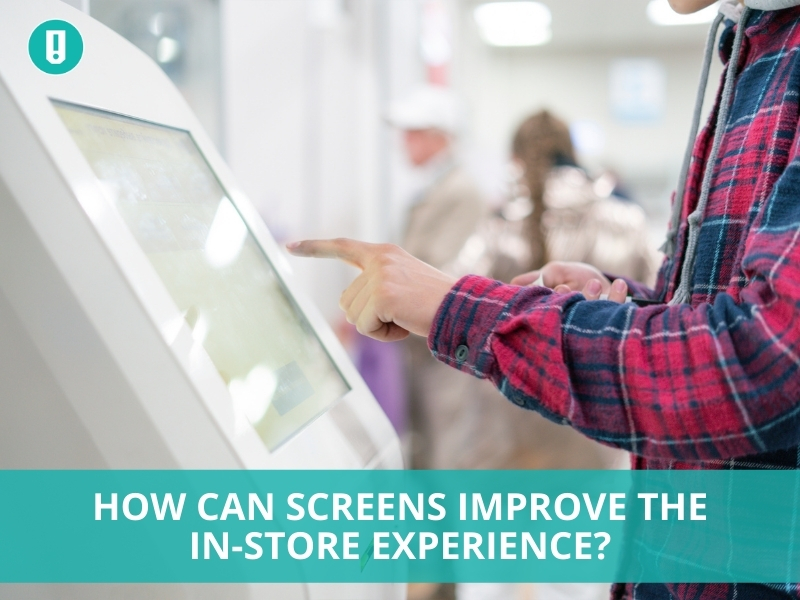Technology has rapidly transformed the world in the past decade, and retail stores are one of those which were largely influenced by it. Over the years, retail store layouts have gone through several changes to enhance the in-store shopping experience and customer satisfaction. This builds brand awareness and inspires engagement within retail spaces.
Nowadays, consumers lean more towards the experience with products which has led retailers to improve and optimize their retail experiences to create exciting, fun, and immersive shopping practices. Experience has become a key marker in a customer’s journey, so shops are looking to swap traditional retail with experiential retail to address consumer needs.
A popular concept being leveraged in retail environments currently is that of interactive screens and kiosks. Physical screens play a vital role in influencing customer experience and create opportunities for retailers to develop more meaningful connections with audiences.
Here are some of the ways in which the implementation of screens is transforming the retail experience.
Provide consumers with valuable product information
Interactive screens have the potential to draw in crowds and entice them to find out more about a brand and its products. In this digital age, surprising shoppers to gain attention has become a challenge. Therefore, going all out with interactive window displays can help intrigue customers using technology.
Utilizing screens across your retail store to engage customers can boost retention and help build a connection with your customers. Retailers can display and highlight important features of their products to grab peoples’ attention and enhance their engagement.
This gets them to actively participate in the store and experience everything in real-time rather than reaching their smartphones to find out about a better product online. These screens allow retailers to not only leave a lasting impression on existing customers but window shoppers as well, so they’re motivated to step inside and see what’s in the store.
Businesses can understand their audiences better
One majorly undervalued yet significant benefit of interactive screens is the ability to learn more about consumer buying habits through analytics. How customers interact with the digital screens displayed across stores is important for gathering valuable data for retailers. This information can be used to improve services, enhance the quality of content, and offer refined shopping experiences.
Businesses can take help from a software development company to create a system that can track valuable customer data such as interests, preferences, and search histories. With this information, retailers will have the advantage to provide customers exactly what they want.
If your interactive screens use a login system, then they can recognize customer identities and offer them customized deals according to their preference every time they log in. In doing so, you’re compelling the customers to stay in your store for longer and purchase an item. Retailers who use this opportunity to empower their business tactics can develop a deeper understanding of their customers to serve them better, both in-store and online.
Interactive screens in-store can dramatically boost sales
The main reason businesses update their practices is to drive sales and establish new streams of revenue. According to recent surveys, two-thirds of the consumers that come into a shop don’t have an idea of what they wish to purchase. Therefore, introducing interactive screens which are scattered across a store can help consumers make a more solid buying decision for themselves.
In simple terms, the digital display won’t tell the customer what to buy but will effectively market specific products to give them that push to make a purchase. Through promotional offers, discounts, bundled deals, and other enticing packages, retailers are offering shoppers with options that are very unlikely to be turned down.
In doing so, the customer walks out with packed shopping bags feeling ecstatic and satisfied. Placing interactive screens in your store can expose potential customers to special offers they can’t resist, which does wonders for your sales.
Businesses can improve customer engagement
Interactive kiosks and screens displayed strategically across a retail store can tempt customers to take a look inside the shop and at the products. They help induce a deeper level of engagement between a brand and its products so the customers have a memorable experience. When customers start remembering your store by experience, they will naturally be inclined to visit frequently and eventually purchase your products.
Humans are curious beings and when we witness something unique, we’re drawn to it. Thus, digital screens allow businesses to capture the attention of window shoppers. The more creative techniques you employ, the better the customer engagement. Once retailers start adding these interactive technologies to their traditional stores, they’ll witness an increase in footfall and sales.
Interactive displays improve the consumer’s buying experience
When you understand the customers better, you provide them better service which, in turn, improves their buying experience. It’s a simple strategy; if you offer shoppers a seamless, modern, and enjoyable shopping experience they will be much more inclined to return to your store and recommend it to others. Your happy customers will be the most effective mode of marketing for your business. Once they start spreading the good word about your brand, you’ll notice a rise in footfall and elevation in revenue.
Touch screens and digital displays innovatively convey a brand’s message to shoppers which convinces them to step into the store and make a purchase. Additionally, they allow consumers to self-service and take the lead during payments which reduces wait time and gives them a sense of independence. This is especially beneficial when it comes to millennials since they prefer doing things on their own.
Wrapping Up
Interactive screens in retail stores allow businesses to combine the digital and physical elements so they can elevate performance, emphasize personalization, boot customer satisfaction and offer better in-store experiences. Retailers can add value to their experience by including visuals that are creative, eye-catching, relatable, and engaging.
It’s a matter of strategic deployment to add a ‘wow’ factor to the store’s layout which can create a modernized shopping experience that helps stores stand out. As of now, more and more brick and mortar stores are making the shift towards digital technology to build stronger customer connections and enhance the in-store experience.
Arslan Hassan is an electrical engineer with a passion for writing, designing, and anything tech-related. His educational background in the technical field has given him the edge to write on many topics. He occasionally writes blog articles for Dynamologic Solutions.







Leave A Comment